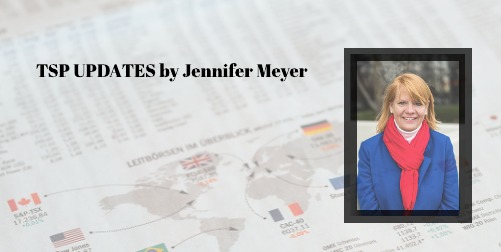STWS Advisor Jen Meyer updates Federal Employees on everything happening with the Thrift Savings Plan (TSP), including the CARES Act and the i-fund

We are keeping a close eye on all things TSP and want to provide you with the latest updates as we wrap up the month.
CARES ACT UPDATE
As of today- there has not been any additional information regarding the rollout of the implementation of the CARES Act withdraw and loan provisions. The latest guidance indicated TSP plans to implement the loan provisions no later than June 22, 2020, and that the withdrawal provisions will be implemented by mid-July 2020. See our article from May 19th for a detailed explanation of the provisions here.
I Fund Changes on Hold
Congress and the President successfully blocked implementation of the changes to the I Fund which were approved in 2017. On May 13th the TSP Board announced it will hold off on implementation of the change which would have expanded the I fund to include a broader representation of the global economy. The change became controversial in the political debate over China. The TSP becoming a bargaining chip in Washington is going to be something we are watching closely over the coming months.
Implementation of TSP Modernization Act- how is it going?
Last Fall the TSP implemented the long-awaited Modernization Act. The Act provided for more flexibility for employees to access their funds both while employed as well as once an employee leaves federal service. The TSP Board reported that in the first month after implementation TSP saw a 47% reduction of lump-sum full account withdraws. In addition, partial withdraws increased 333%. The online wizard was designed to reduce paperwork errors in participants' requests and move towards a digital experience. While participants still have to submit many requests by paper, the process has definitely improved.
The Act also allows a participant to chose whether to take funds from the Traditional or Roth side of their TSP. This is a critical improvement that provides additional flexibility for tax planning and strategy. Overall, the feedback we have received from both employees and financial advisors indicate these changes have been well received.
However, what is lacking in the new rules is the ability to designate which funds to take withdraws from. Market volatility like we have been recently experiencing necessitates that a participant be able to designate which funds to withdraw from. Let’s take a hypothetical example. If a participant has their funds equally in the G and C funds and desires to take a withdraw- current rules dictate that the withdraw will be taken 50% from G and 50% from C. At a time when the C fund is down significantly, like it was in mid-March 2020, the participant would be much better off to take the full withdraw from the G fund only versus selling shares of the C fund at that time. Remember, as an investor- the goal is to sell high and buy low. This TSP restriction forces this investor to sell their C fund at a time when strategically they would be better off selling only from G.
We have been talking to our federal employees individually about current market volatility and reviewing TSP allocations and contributions during these uncertain times. Please do not hesitate to reach out to us with questions and concerns. We love to help!
**Written by Jennifer Meyer, Financial Planner. The information has been obtained from sources considered reliable but we do not guarantee that the foregoing material is accurate or complete. Any opinions are those of Jennifer Meyer and not necessarily those of RJFS or Raymond James. Any information is not a complete summary or statement of all available data necessary for making an investment decision and does not constitute a recommendation. Investing involves risk and you may incur a profit or loss regardless of strategy suggested. Every investor’s situation is unique and you should consider your investment goals, risk tolerance, and time horizon before making any investment or financial decision. Prior to making an investment decision, please consult with your financial advisor about your individual situation. While we are familiar with the tax provisions of the issues presented herein, as Financial Advisors of RJFS, we are not qualified to render advice on tax or legal matters. You should discuss tax or legal matters with the appropriate professional.**

TSP Updates
